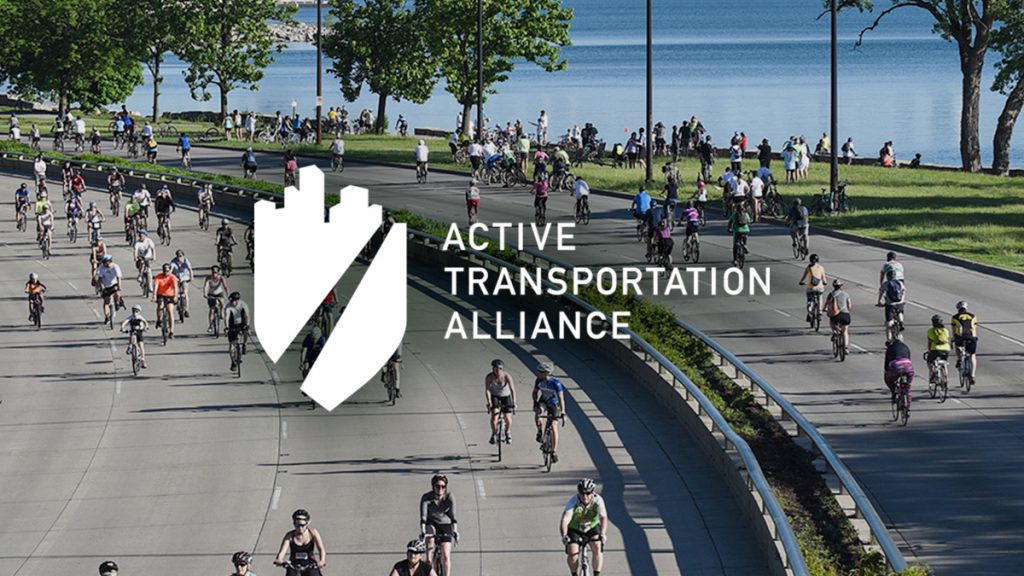Released: June 13, 2013
This is an updated version of a news release that was sent out on the morning of Thursday, June 13
Ethan Spotts
Active Transportation Alliance
312.427.3325 x 287 (o)
312.919.1423 (c)
[email protected]
New Milwaukee Ave. bike lane to improve commute for thousands of people who bike to work
The Active Transportation Alliance congratulates Mayor Rahm Emanuel, 27th Ward Alderman Walter Burnett and the Chicago Department of Transportation for the successful completion of the city’s newest bike lane on Milwaukee Ave. between Kinzie St. and Elston Ave. This new innovative bike lane uses a combination of buffered, barrier-protected and conventional bike lanes to make people riding bikes feel safer and give them greater separation from auto traffic.
“I can’t think of a better way to celebrate Bike to Work Week in Chicago than with the completion of a cutting-edge bike lane on the city’s busiest route for bike commuters,” said Ron Burke, executive director of the Active Transportation Alliance. “Every day thousands of people ride their bikes down Milwaukee Ave. to workplaces in the Loop, making it one of the busiest streets for cycling in the entire country. Now it will be one of the safest as well. This is a huge step forward for our efforts to make Chicago the best city for biking in the country.”
The new Milwaukee Ave. bike lane is the latest in a series of bike infrastructure improvement projects carried out under the city’s Streets for Cycling Plan 2020. Among the core elements of the plan is a network of “spoke routes” along key streets like Milwaukee Ave. that will create direct links between outlying neighborhoods and the city’s central business district.
The new bike lane on Milwaukee Ave. includes traditional bike lanes, protected bike lanes — which use physical barriers to separate people riding bikes and motorized traffic — and buffered bike lanes, which are similar to conventional bike lanes but with extra padding that keeps people biking further from moving traffic and away from the danger of car doors opening in their path.
By providing people on bikes with their own protected space, the design of the new lane on Milwaukee Ave. helps people of all ages feel more comfortable biking on city streets. Active Trans’ Neighborhood Bikeways Campaign is mobilizing thousands of people from across Chicago to achieve our goal of building a 100-mile network of protected bikeways by 2015.
“This project showcases the widespread public support for new and safer types of bike lanes in Chicago. Almost 3,000 people signed a petition we circulated supporting the project,” said Lee Crandell, Director of Campaigns at Active Trans. “People know bringing these types of improvements to Milwaukee Ave. will address safety issues along the corridor, which includes some of the most dangerous bicycling intersections in the city, such as the intersection at Grand, Milwaukee and Halsted.”
Statistics show barrier-protected bike lanes in particular encourage more people to bike while improving overall safety for everyone using the street, whether they walk, bike or drive. A study recently published in the American Journal of Public Health found that risk of injury is 89 percent lower biking on protected bike lanes compared to major streets with no bike infrastructure.
In addition to addressing safety concerns, the new spoke route will create a stronger connection between existing bikeways on Elston Ave., Kinzie and Dearborn Streets.
“With this latest addition on Milwaukee Ave., you can really start to see the network of innovative bike lanes starting to take shape across the city,” said Crandell. “Not only will the network improve access to Chicago’s neighborhoods and enhance overall quality of life for people already living in the city, it will also help attract new residents and businesses seeking to put roots down in a region that promotes active lifestyles and livability.”
The Active Transportation Alliance is a non-profit, member-based advocacy organization that works to make bicycling, walking and public transit so safe, convenient and fun that we will achieve a significant shift from environmentally harmful, sedentary travel to clean, active travel. The organization builds a movement around active transportation, encourages physical activity, increases safety and builds a world-class transportation network. The Active Transportation Alliance is North America’s largest transportation advocacy organization, supported by nearly 7,000 members, 1,000 volunteers and 40 full-time staff. For more information on the Active Transportation Alliance, visit www.activetrans.org or call 312.427.3325.

